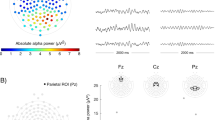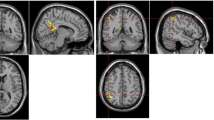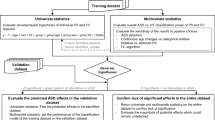Abstract
Abnormal brain oscillatory activity has been found in autism spectrum disorders (ASD) and proposed as a potential biomarker. While several studies have investigated gamma oscillations in ASD, none have examined resting gamma power across multiple brain regions. This study investigated resting gamma power using EEG in 15 boys with ASD and 18 age and intelligence quotient matched typically developing controls. We found a decrease in resting gamma power at right lateral electrodes in ASD. We further explored associations between gamma and ASD severity as measured by the Social Responsiveness Scale (SRS) and found a negative correlation between SRS and gamma power. We believe that our findings give further support of gamma oscillations as a potential biomarker for ASD.



Similar content being viewed by others
References
Achenbach, T. M. (1991). Manual for the child behavior checklist/4–18 and 1991 profile. Burlington: VT University of Vermont.
American Psychiatric Association. (2000). Diagnostic and statistical manual of mental disorders—iv -tr (4th ed.). Washington, DC: American Psychiatric Association.
Constantino, J. N., Gruber, C. P., Davis, S., Hayes, S., Passanante, N., & Przybeck, T. (2004). The factor structure of autistic traits. Journal of Child Psychology and Psychiatry, 45, 719–726.
Cornew, L., Roberts, T. P., Blaskey, L., & Edgar, J. C. (2012). Resting-state oscillatory activity in autism spectrum disorders. Journal of Autism and Developmental Disorders, 42, 1884–1894.
Dawson, G., Klinger, L. G., Panagiotides, H., Lewy, A., & Castelloe, P. (1995). Subgroups of autistic children based on social behavior display distinct patterns of brain activity. Journal of Abnormal Child Psychology, 23, 569–583.
Delorme, A., & Makeig, S. (2004). EEGLAB: An open source toolbox for analysis of single-trial EEG dynamics including independent component analysis. Journal of Neuroscience Methods, 134, 9–21.
Fox, N. A., Rubin, K. H., Calkins, S. D., Marshall, T. R., Coplan, R. J., Porges, S. W., et al. (1995). Frontal activation asymmetry and social competence at four years of age. Child Development, 66, 1770–1784.
Gandal, M. J., Edgar, J. C., Ehrlichman, R. S., Mehta, M., Roberts, T. P., & Siegel, S. J. (2010). Validating gamma oscillations and delayed auditory responses as translational biomarkers of autism. Biological Psychiatry, 68, 1100–1106.
Gleissner, U., Von Ondarza, G., Freitag, H., & Karlmeier, A. (2003). Auswahl einer HAWIK-III-Kurzform fur Kinder und Jugendliche mit Epilepsie. Zeitschrift fur Neuropsychologie, 14, 3–11.
Gonzalez-Burgos, G., Hashimoto, T., & Lewis, D. A. (2010). Alterations of cortical GABA neurons and network oscillations in schizophrenia. Current Psychiatry Reports, 12, 335–344.
Gonzalez-Burgos, G., & Lewis, D. A. (2008). GABA neurons and the mechanisms of network oscillations: Implications for understanding cortical dysfunction in schizophrenia. Schizophrenia Bulletin, 34, 944–961.
Kaufman, J., Birmaher, B., Brent, D., Rao, U., Flynn, C., Moreci, P., et al. (1997). Schedule for Affective Disorders and Schizophrenia for School-Age Children-Present and Lifetime Version (K-SADS-PL): Initial reliability and validity data. Journal of the American Academy of Child and Adolescent Psychiatry, 36, 980–988.
Keren, A. S., Yuval-Greenberg, S., & Deouell, L. Y. (2010). Saccadic spike potentials in gamma-band EEG: Characterization, detection and suppression. Neuroimage, 49, 2248–2263.
Kohls, G., Peltzer, J., Schulte-Ruther, M., Kamp-Becker, I., Remschmidt, H., Herpertz-Dahlmann, B., et al. (2011). Atypical Brain Responses to Reward Cues in Autism as Revealed by Event-Related Potentials. Journal of Autism and Developmental Disorders, 41, 1523–1533.
Lord, C., Risi, S., Lambrecht, L., Cook, E. H., Jr, Leventhal, B. L., Dilavore, P. C., et al. (2000). The autism diagnostic observation schedule-generic: A standard measure of social and communication deficits associated with the spectrum of autism. Journal of Autism and Developmental Disorders, 30, 205–223.
Lord, C., Rutter, M., & Le Couteur, A. (1994). Autism Diagnostic Interview-Revised: A revised version of a diagnostic interview for caregivers of individuals with possible pervasive developmental disorders. Journal of Autism and Developmental Disorders, 24, 659–685.
Magnee, M. J., De Gelder, B., Van Engeland, H., & Kemner, C. (2011). Multisensory integration and attention in autism spectrum disorder: Evidence from event-related potentials. PLoS ONE, 6, e24196.
Marco, E. J., Hinkley, L. B., Hill, S. S., & Nagarajan, S. S. (2011). Sensory processing in autism: A review of neurophysiologic findings. Pediatric Research, 69, 48R–54R.
Muller, M. M., Keil, A., Gruber, T., & Elbert, T. (1999). Processing of affective pictures modulates right-hemispheric gamma band EEG activity. Clinical Neurophysiology, 110, 1913–1920.
Oldfield, R. C. (1971). The assessment and analysis of handedness: The Edinburgh inventory. Neuropsychologia, 9, 97–113.
Rojas, D. C., Maharajh, K., Teale, P., & Rogers, S. J. (2008). Reduced neural synchronization of gamma-band MEG oscillations in first-degree relatives of children with autism. BMC Psychiatry, 8, 66.
Rojas, D. C., Teale, P. D., Maharajh, K., Kronberg, E., Youngpeter, K., Wilson, L. B., et al. (2011). Transient and steady-state auditory gamma-band responses in first-degree relatives of people with autism spectrum disorder. Mol Autism, 2, 11.
Rubenstein, J. L., & Merzenich, M. M. (2003). Model of autism: Increased ratio of excitation/inhibition in key neural systems. Genes Brain Behav, 2, 255–267.
Rutter, M., Bailey, A., & Lord, C. (2003). Social Communication Questionnaire. Manual for the SCQ. Los Angeles, CA: Western Psychological Services.
Sheikhani, A., Behnam, H., Mohammadi, M. R., Noroozian, M., & Mohammadi, M. (2010). Detection of abnormalities for diagnosing of children with autism disorders using of quantitative electroencephalography analysis. Journal of Medical Systems, 36, 957–963.
Sheikhani, A., Behnam, H., Noroozian, M., Mohammadi, M. R., & Mohammadi, M. (2009). Abnormalities of quantitative electroencephalography in children with Asperger disorder in various conditions. Research in Autism Spectrum Disorders, 3, 538–546.
Sohal, V. S., Zhang, F., Yizhar, O., & Deisseroth, K. (2009). Parvalbumin neurons and gamma rhythms enhance cortical circuit performance. Nature, 459, 698–702.
Uhlhaas, P. J., & Singer, W. (2010). Abnormal neural oscillations and synchrony in schizophrenia. Nature Reviews Neuroscience, 11, 100–113.
Acknowledgments
This study was supported by the German Research Foundation (Deutsche Forschungsgemeinschaft/DFG, IRTG 1328). Christina Maxwell is supported by the Institute for Translational Medicine and Therapeutics at the University of Pennsylvania.
Author information
Authors and Affiliations
Corresponding author
Rights and permissions
About this article
Cite this article
Maxwell, C.R., Villalobos, M.E., Schultz, R.T. et al. Atypical Laterality of Resting Gamma Oscillations in Autism Spectrum Disorders. J Autism Dev Disord 45, 292–297 (2015). https://doi.org/10.1007/s10803-013-1842-7
Published:
Issue Date:
DOI: https://doi.org/10.1007/s10803-013-1842-7




